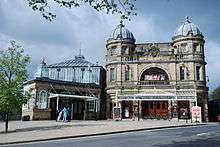Buxton Opera House



Buxton Opera House is in The Square, Buxton, Derbyshire, England. It is a 902-seat opera house that hosts the annual Buxton Festival and, from 1994 to 2013, the International Gilbert and Sullivan Festival, among others, as well as pantomime at Christmas, musicals and other entertainments year-round. Hosting live performances until 1927, the theatre then was used mostly as a cinema until 1976. In 1979, it was refurbished and reopened as a venue for live performance.
History
It was built in 1903 and designed by Frank Matcham, one of Britain's finest theatre architects. He also designed two famous London theatres: the London Palladium (1910) and the London Coliseum (1904).
The Opera House ran as a successful theatre, receiving touring companies until 1927, when it was turned into a cinema. Silent films were shown until 1932 when the theatre was wired for sound and could present ‘talkies’. The Opera House also became the venue for an annual summer theatre festival from 1936 to 1942, two of them in conjunction with Lillian Bayliss and her London-based Old Vic company. After the Second World War, the theatre continued to serve primarily as a cinema, although the Literary and Dramatic Societies of local schools Buxton College and Cavendish Grammar School staged annual performances of either Shakespeare, such as Hamlet (1966), Coriolanus (1968) and Macbeth (1970), or modern works, such as Bertold Brecht's Life of Galileo (1967) and Dylan Thomas's The Doctor & the Devils (1969).[1]
In 2014, the opera house's former finance chief was jailed for two years for stealing nearly £250,000 from the opera house accounts in 2012 and 2013.[2]
Refurbishment and reception

The Opera House gradually fell into disrepair. In 1976, it was closed and rumours circulated that it would never reopen. In 1979, however, it was restored and an orchestra pit was added to the original Frank Matcham design. Since then, the Opera House has been a full-time venue for stage productions, presenting approximately 450 performances per year, including opera, dance, musical theatre, pantomime, comedy, drama, children's shows and concerts. The theatre is staffed by a small full-time technical crew for all the backstage work, setting up all the shows and artists that appear. Volunteers from the local community are also employed for front-of-house duties including bar work and as ushers.
By the 1990s, more work was needed to repair and modernise the theatre, and from 1999 to 2001 an extensive programme of internal and external restoration took place. In February 2007, another refurbishment was completed at the Opera House that saw the installation of air conditioning in the gallery and backstage area, new seats in the gallery and upper circle, a new get-in lift to replace the ramp and new backstage working lights as well as re-wiring and painting the backstage area and dressing rooms. The current capacity is 902 seats.[3]
In 2011, FT Magazine featured an article on opera house design. In the section called "My favourite experiences", the writer praised the European opera houses "designed by the Viennese architectural firm of Fellner and Helmer (the Zurich Opera House is [an] example) ... [which] represent a near-ideal marriage of size, acoustic and decorative beauty. Their British equivalents are those designed by Frank Matcham – best of all the Buxton Opera House."[4]
Theatre complex
The theatre complex also includes the adjacent Pavilion Gardens, the 369-seat Pavilion Arts Centre (rebuilt in 2010; formerly the Paxton Theatre),[3] and the Octagon Hall auditorium (built in 1875), as well as a two-storey restaurant with a bar and gift shop. The arts centre stage area can be converted into a separate 93-seat studio theatre.[5]
Festivals
Since July 1979, the Opera House and theatre complex has been home to the Buxton Festival, which runs for about two weeks in mid-July and has developed into one of Britain's largest opera-based festivals. Typically, it includes a Handel opera (with conductors such as Harry Christophers) and other rarely seen operas as well as more popular classics. Running alongside it is the Buxton Festival Fringe. It is popular as a warm-up for the Edinburgh Fringe, and it now claims to be the largest 'true' fringe festival in the UK. From 1994 to 2013, the Opera House also hosted the annual three-week-long International Gilbert and Sullivan Festival, attracting audiences from all over the UK and from abroad.[6]
The Opera House presents over 400 performances each year.[7] Since 2004, the Opera House and the neighbouring Pavilion Gardens have hosted the annual Four Four Time music festival which sees a wide variety of musical performances over one week in February. Performers for the 2008 festival included Marc Almond, Richard Hawley, The Stranglers and Boy George.
References
- Notes
- ↑ Bolton King, R 1973 Buxton College, 1675–1970
- ↑ "Ex-finance chief jailed for £250,000 Buxton Opera House fraud", Buxton Advertiser, 4 July 2014.
- 1 2 Woolman, Natalie. "Buxton Opera House to open new Pavilion arts venue". The Stage, 7 September 2010
- ↑ Clark, Andrew. "Something completely magical: My favourite opera experiences", FT Magazine, 21 October 2011
- ↑ "The opening of the Pavilion art centre Buxton". Derbyshire Life, 26 August 2010
- ↑ Christiansen, Rupert. "Gilbert and Sullivan Festival bows out of Buxton", The Telegraph, 15 July 2013
- ↑ "Buxton Opera House". Paul Iles & The Laughing Audience, accessed 18 February 2011
External links
Coordinates: 53°15′31″N 1°54′57″W / 53.2586°N 1.9157°W
